- 1Fisheries College, Guangdong Ocean University, Zhanjiang, China
- 2Pearl Oyster Research Institute, Guangdong Ocean University, Zhanjiang, China
- 3Guangdong Provincial Key Laboratory of Aquatic Animal Disease Control and Healthy Culture, Guangdong Ocean University, Zhanjiang, China
Heatwaves and bioinvasion are among the most pressing ecological issues worldwide. The highly invasive South American mussels (Mytella strigata) can construct extremely dense byssal mats in intertidal habitats they invade, causing serious threats to local biodiversity and ecosystems. Yet, little is known about whether intensifying heatwaves might facilitate their invasions. Here, we investigated how the byssus production of M. strigata responds to heatwaves scenarios that have frequently occurred in recent years in the South China Sea. Compared with those grown at ambient temperature, mussels exposed to simulation heatwaves secreted significantly lowered number, length, and diameter of byssal threads, and exhibited significant impairments in the adhesion of byssus. Differential expressions of key genes involved in byssus production (e.g., foot protein gene, cell apoptosis gene, extracellular matrix-receptor interaction gene, and neuroactive ligand-receptor interaction gene) offered deeper insights into heatwaves-induced physiological changes in byssal gland. These results can provide an improved understanding of responses of mussel byssus production to intensifying heatwaves and take a major leap forward in examining the dispersal of highly invasive species in a rapidly warming ocean.
1 Introduction
Climate change has driven the Earth’s surface temperatures to increase over the past decades, and simultaneously led to the widespread prevalence of heatwaves (IPCC, 2019). Specifically, regional extremes of atmospheric temperatures above any historical baseline could be termed heatwaves (Hobday et al., 2016). Heatwaves are projected to increase the frequency, intensity, and duration (Frölicher et al., 2018; Perkins-Kirkpatrick and Lewis, 2020) in current era of unprecedented climate change, and cause devastating ecological consequences and economic losses (Smith et al., 2021). Intertidal ecosystems are among the most ecologically and economically productive in the world, but are frequently attacked by intensifying heatwaves (Leung et al., 2019). Atmospheric temperature changes at low tide in the intertidal zone are far more dramatic and extreme than sea surface temperatures (Helmuth et al., 2016; He et al., 2022). Organisms inhabiting intertidal habitats are consequently susceptible to intensifying heatwaves (Balogh and Byrne, 2020; Scanes et al., 2023). Nevertheless, compared with native organisms in the intertidal ecosystems, the fate of highly invasive organisms frequently attacked by heatwaves has received much less attention (Crespo et al., 2021), constraining our capability to assess whether extreme weather events like heatwaves might facilitate their invasions.
Biological invasion represents one of the most urgent ecological threats to global biodiversity (Bellard et al., 2017). Especially, the swiftly spreading invasive mytilid mussels have caused serious fouling issues in intertidal ecosystems worldwide, affecting the local biodiversity, fishery productivity and ecosystem functioning (Amini et al., 2017; Zhao et al., 2020). Charru mussels, Mytella strigata, native to the Atlantic coast of South America from Venezuela to Argentina, represent one of the most typically invasive fouling mytilid species (Sanpanich and Wells, 2019). Over the last decade, M. strigata has rapidly invaded many Asian countries from the tropical Western Atlantic, such as China, the Philippine, and Singapore (Mediodia et al., 2017; Lim et al., 2018; Ma et al., 2022). In the intertidal zone, M. strigata can form dense mussel beds by adhering to various substrates and conspecifics (as shown in Figure 1), preventing almost all other epifauna and infauna from surviving and reducing the area of suitable habitats for motile organisms (Wangkulangkul et al., 2022; Xu et al., 2023b). The strong attachment of byssus to the substratum is the key in sustaining the rapid invasion and fouling of mytilid mussels (Li et al., 2018). Under the context of climate change, consequently, gaining a better understanding of responses of mussel byssus production to extreme weather events such as heatwaves is critical for mussel invasion assessment.
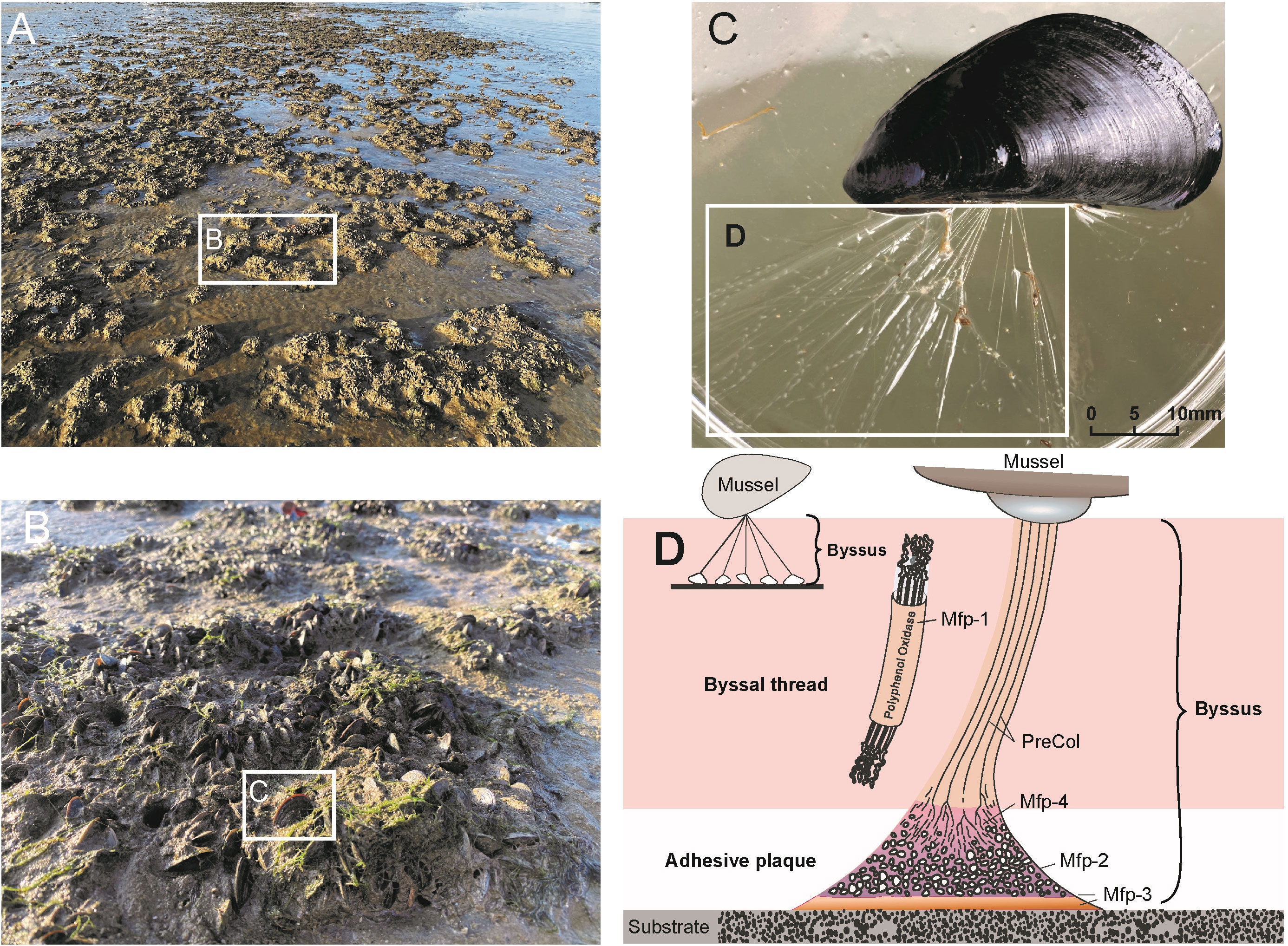
Figure 1 Bioinvasion of Mytella strigata in intertidal ecosystems in the South China Sea, and schematic illustrating the structure of byssus. (A) Newly observed mussel invasion in the intertidal zone of Zhangjiang bay. (B) Construction of extremely dense byssal mats. (C) Byssus building from M. strigata. (D) Foot proteins and polyphenol oxidase in the byssus of M. strigata.
Mussel byssus is an exogenous attachment structure, which is composed of byssal thread and adhesive plaque and secreted by byssal gland, as schematically illustrated in Figure 1. Several proteins synthesized in byssal glands have been identified for byssus formation. For example, Mfp-1 (mussel foot protein-1) is mostly located over the first layer of the byssal thread, Mfp2-4 involved in adhesive plaque attachment, and the precursor collagen known for the building of the byssal framework (Lin et al., 2007; Lee et al., 2011). Element such as Zn2+, Fe3+, Ca2+, Al3+ can cross-link with foot proteins through polyphenol oxidase, and play major roles in maintaining the structure and mechanical properties (ductility and rigidity) of byssus (Zhao and Waite, 2006; Li et al., 2018). At the molecular aspect of biological organization, differential expressions of genes in byssal glands can affect the quality and efficiency of byssus production (Li et al., 2017). Ample evidence suggests that the strength of byssus attachment could be dependent on environmental conditions, including food availability, seawater temperature, salinity and acidity (e.g., O’Donnell et al., 2013; Schmitt et al., 2015a; Li et al., 2017; Shang et al., 2021; Huang et al., 2022). Nevertheless, to our knowledge, very little research has been focused on how extreme weather events, especially heatwaves, affect the byssus production of highly invasive mytilid mussels.
The current study aimed at obtaining a deeper understanding of how intensifying heatwaves affect the byssus production of the highly invasive mussel M. strigata that has rapidly invaded the intertidal ecosystems of the South China Sea. Considering the remarkable physiological capacity of M. strigata to cope with heatwaves (Xu et al., 2023a), it is reasonable to hypothesize that at the individual level of biological organization the ability of M. strigata to secrete byssus and attach to the substratum may not be affected by intensifying heatwaves that occur frequently in the South China Sea. It would appear that this species might continue to rapidly invade intertidal ecosystems in an unprecedented climate change era if that were the case.
2 Materials and methods
2.1 Mussel collection and husbandry
On September 17, 2022, individuals of one-year-old M. strigata (shell length: 20 ± 2 mm, shell width 15 ± 2 mm, shell height 41 ± 3 mm, wet weight 5.5 ± 0.5 g) were carefully hand-collected from Zhanjiang Bay intertidal areas in the South China Sea, during low tide. As shown in Figure 1, M. strigata has already invaded the bay and constructed extremely dense byssal mats, which are causing serious fouling problems. The density of the mussels at the sampling site was over 6,000 individuals per square meter. Seawater and atmospheric temperatures on the collection day were 27.5°C and 32°C, respectively, and an immersion-emersion tidal cycle (18 hours/6 hours) was observed. Upon arrival to the laboratory, mussels were separated by carefully cutting off byssal threads with scissors and washed several times with pre-sand-filtered seawater to eliminate any surface dirt. Following, mussels were acclimated in the 30,000-L recirculating aquarium for two weeks. Conditions during acclimation were similar to those recorded at sampling and collection sites. Seawater pH maintained constantly at 8.1, salinity at 32, temperature at 27°C, dissolved oxygen concentration above 6.5 mg/L. The aquarium was supplied with Platymonas sp. at a density of 20,000cells mL-1 on a daily basis. Likewise, a daily immersion-emersion cycle of was set at 18 h/6 h to mimic natural conditions. No mortality was observed during the period of laboratory acclimation.
2.2 Experimental setup
A scenario for the prevalence of heatwaves in the South China Sea during summertime was deliberately simulated to assess impacts on the byssus production of M. strigata inhabiting intertidal habitats. Specifically, the average temperature of 32°C recorded in Zhanjiang Bay was used as the baseline condition, and stimulated a heatwave scenario with an air temperature regime of 40°C during the prevalence of the heatwaves. In the last decade, summer temperatures in the South China Sea have reached 40°C with increasing frequency and duration (Zhang et al., 2020), in line with recent reported regularly announced by the China Meteorological Administration. Therefore, the South China Sea heatwave scenario manipulated in the current study is considered environmentally realistic levels of stress.
After two weeks of laboratory acclimation, as schematically illustrated in Figure 2, a total of 270 specimens were randomly assigned to each group for experimentation. The first group was exposed to ambient temperatures to simulate the baseline and the other group exposed to the simulated scenario of heatwaves manipulated by thermostats. Each experimental system was composed of three exposure replicates, i.e., a total of 45 individuals per replicate. During the experiment and on a daily basis, M. strigata were subjected to 6 hours of aerial exposure followed by 18 hours of immersion in the flow-through seawater system. The experiment lasted five days, which corresponds to the average duration of heatwaves in the region (Zhang et al., 2020; He et al., 2022). Continuous monitoring of seawater and atmospheric temperatures with HOBO temperature data loggers, with the seawater temperature of 27.5 ± 0.5°C during immersion, and atmospheric temperatures of 32 ± 2°C and 40 ± 0.5°C at ambient and heatwaves conditions during emersion, respectively. On the 1st, 3rd, and 5th days of the experimental period, 15 mussels were sampled randomly from each experimental system (i.e., 5 individuals from each replicate) for the analysis of byssus. Specifically, the byssus of each mussel was carefully cut off, and the left valve of the shell was then fixed on the petri dish with a quick-drying glue. Mussels were placed back to the corresponding systems for 24 hours for the re-building of their byssus, and the byssal gland of each mussel were carefully dissected, quick-freeze in liquid nitrogen and keep at -80°C for subsequent analysis. Likewise, byssus randomly sampled from a total of 30 individuals in each system were collected at the end of the experiment pending analyses of metal ion content.
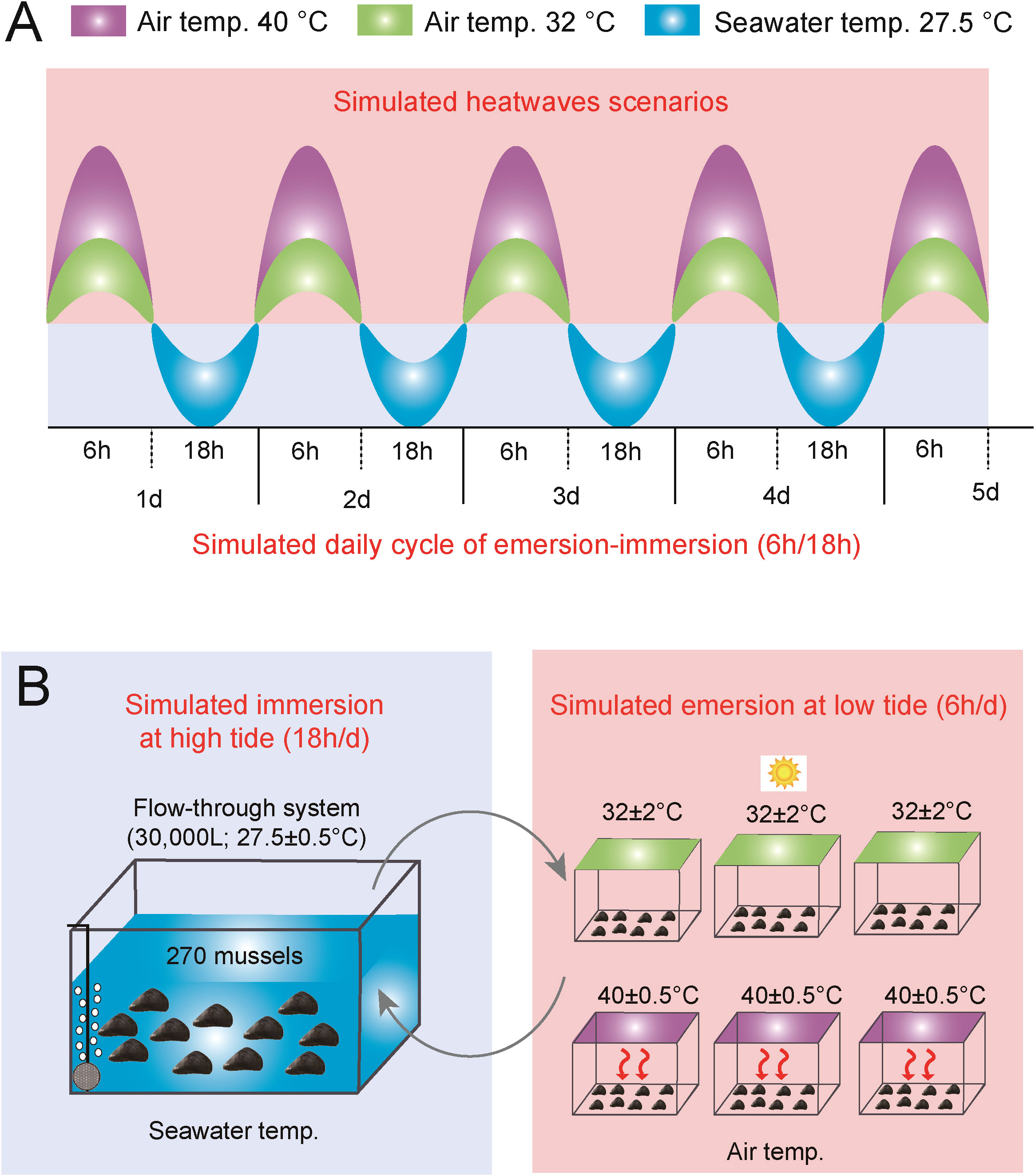
Figure 2 Overview of the experimental setup investigating the impact of heatwaves on the byssus attachment of Mytella strigata. (A) Tidal emersion-immersion cycle of 6 h/18 h at the sampling site and the day of collection, and simulation of tidal cycle that mussels experienced daily in the laboratory. (B) Scenarios of intensity and duration of atmospheric heatwaves that mussels experienced over a tidal cycle.
2.3 Byssus quantitative and qualitative analysis
To evaluate the impact of heatwaves on mussel byssus production, 15 mussels were randomly selected from each experimental system, and the number of byssal threads secreted by each mussel was counted with a stereomicroscope, and the diameter and length of corresponding byssal threads were then measured using an electronic caliper. Since the byssal thread is approximately cylindrical, its volume was calculated from its length and diameter (Zhao et al., 2020; Xu et al., 2023b). The ultrastructure of byssal threads and adhesive plaque was observed under electron microscope. The metal ion concentration of byssal threads was measured using an Agilent 7500cx inductively coupled plasma mass spectrometer by adopting methods from Liu et al. (2015). To eliminate potential contaminants, the byssal samples were rinsed 3 times with Mili-Q water. They were then dried in sealed containers. Concentrations of zinc (Zn2+), iron (Fe3+), calcium (Ca2+), and aluminum (Al3+) which are closely related to the synthesis of foot proteins were measured, and expressed as mg metal·g byssus−1 (Li et al., 2017).
2.4 Byssal gland biochemical and molecular analysis
The polyphenol oxidase (PPO) activity of the byssal gland was assessed to understand the oxidation state of byssal gland Dopa when heatwaves attacked. The byssal gland of each mussel was dissected carefully from each mussel, and a total of five individuals in each system were randomly selected for biochemical analysis. The PPO activity was determined using a commercial enzyme activity kit bought from Nanjing Jiancheng Institute of Biological Engineering (Nanjing, China) according to the manufacturer’s directions.
To evaluate the impact of heatwaves on the gene expression in the byssal gland, four categories of key genes involved in byssus production (foot protein gene, cell apoptosis gene, extracellular matrix-receptor interaction gene, neuroactive ligand-receptor interaction gene) were selected. Gene categories and primer pairs designed with Primer Premier 5 software are displayed in Table 1. The extraction of total RNA, the preparation of cDNA, and the analysis of quantitative real-time PCR (qRT-PCR) from byssal glands were carried out following the method described in He et al. (2023). Specifically, RNA was extracted according to the Trizol manufacturer’s directions, RNA concentration of byssal gland was checked by a Thermo Scientific NanoPhotometer spectrophotometer, and RNA integrity of byssal gland was determined by agarose gel electrophoresis. RNA of high quality was chosen for cDNA preparation on ice. The cDNA preparation system contains 4 μL of 5× TransScript Uni All-in-One SuperMix for qPCR, 1 μL of gDNA Remover, and 15 μL of RNase-free Water and RNA. The 20 μL system was mixed softly, then incubated at 50°C for 5 min, and heated at 85°C for 2 min to inactivate TransScript Uni RT and gDNA Remover. The system of qRT-PCR reaction consists of 5 μL 2 x PerfectStart Green qPCR SuperMix, 0.4 μL upstream primers, 0.4 μL downstream primers, 0.4 μL cDNA, 3.8 μL Nuclease-free Water. The program was set as pre-incubation for 300 seconds at 95°C, then 3-step amplification of 45 cycles (95°C for 10 sec, 60°C for 15 sec, 72°C for 10 sec, respectively), and melting was set at 95°C for 10 sec, at 65°C for 60 sec, and at 95°C for 1 sec. Using β-actin as an internal reference gene, the relative expression levels of individual gene was computed by means of the comparative Ct method (2−ΔCt) (Ding et al., 2018).
2.5 Statistical analysis
All experiment data were statistically analyzed using the software SPSS 25.0. The F-test and Shapiro-Wilk’s test were applied to test the data homogeneity and normality, respectively. A two-way analysis of variance (ANOVA) was performed to assess the impact of heatwaves varying in intensity and duration on the properties (number, length, diameter, volume and elemental concentration) of byssal threads, and the PPO activity of byssal glands. The metal ion concentration of byssal threads was examined by one-way ANOVA at the end of experiment. p < 0.05 demonstrates statistically significant differences between treatments.
3 Results
As demonstrated in Figure 3, exposure of M. strigata to simulated heatwaves significantly affected its byssus production. The duration and intensity of heatwaves, along with their interaction, dramatically affected the number of byssal threads (p < 0.05; Figure 3A). On days 3 and 5, mussels stressed by heatwaves secreted significantly smaller amount of byssal threads than those thrive at ambient temperatures (p < 0.05). The length of byssal threads was significantly affected by the duration and intensity of simulated heatwaves (p < 0.05; Figure 3B), however, no significance interaction was observed between the two factors (p > 0.05). In line with results in the number of byssal threads, the duration and intensity of simulated heatwaves and their interaction significantly affected the diameter (p < 0.05; Figure 3C) and the volume (p < 0.05; Figure 3D) of byssal threads, in particular with significant impacts mostly pronounced on days 3 and 5 (p < 0.05). More specifically, on days 3 and 5, the effect was significant (p < 0.05), but there was no effect on day 1 (p > 0.05). The interaction between heatwaves intensity and duration indicated that the combination of heatwaves intensity and duration had a significant effect on the number, diameter, and volume of byssal threads.
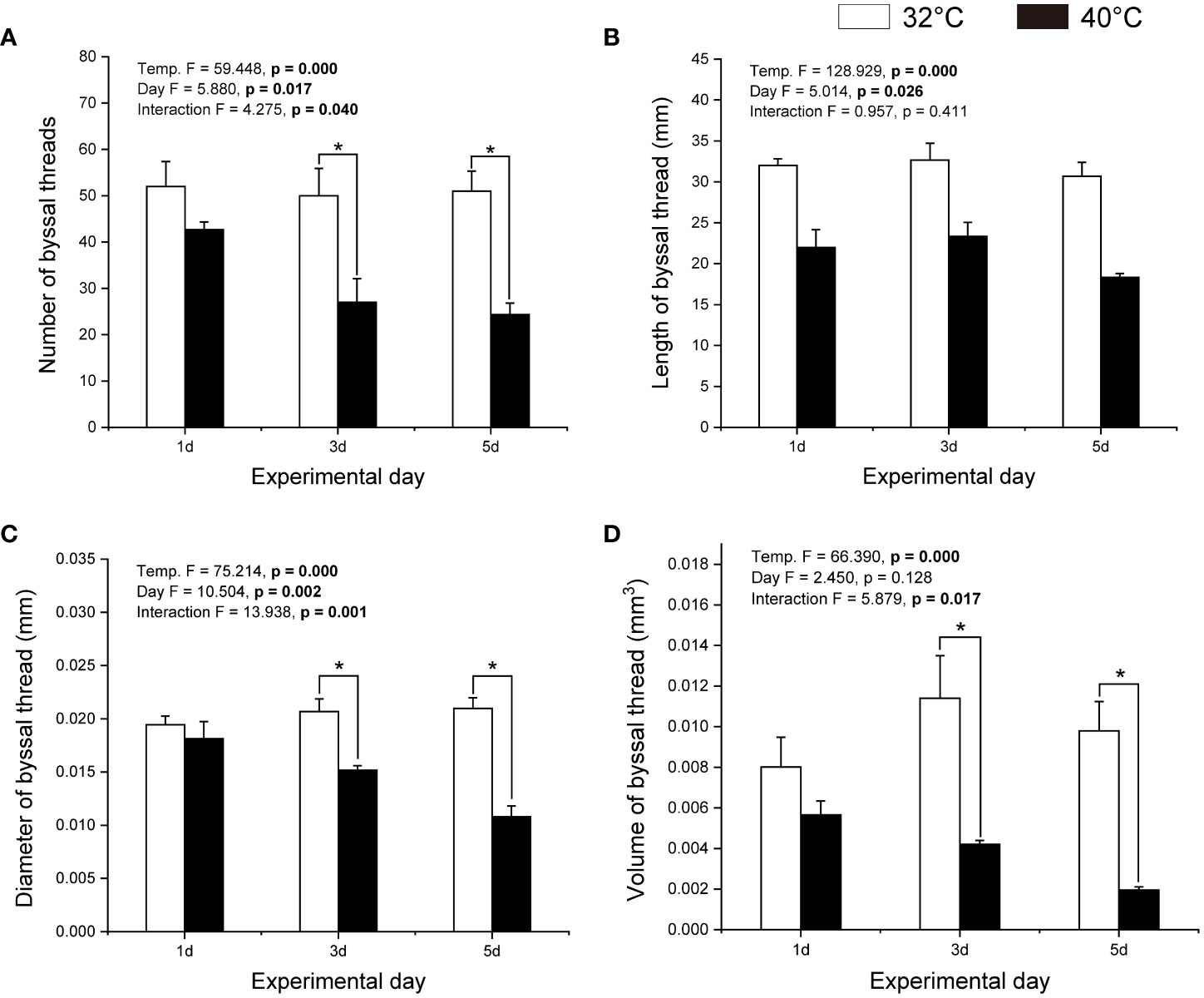
Figure 3 Impacts of heatwaves on the number (A), length (B), diameter (C) and volume (D) of byssal threads in Mytella strigata. Two-way ANOVA analysis indicates impacts of the intensity and duration of heatwaves on the byssus production, and asterisk denotes statistically significant differences between treatments on the same experimental day.
Under the electron microscope, as shown in Figure 4, the diameter of byssal threads secreted from heatwaves-stressed mussels (Figure 4A) was evidently smaller than those formed under ambient temperature (Figure 4B). Exposure of mussels to simulated heatwaves made adhesive plaque much smaller than those produced by unstressed mussels (Figures 4C, D).
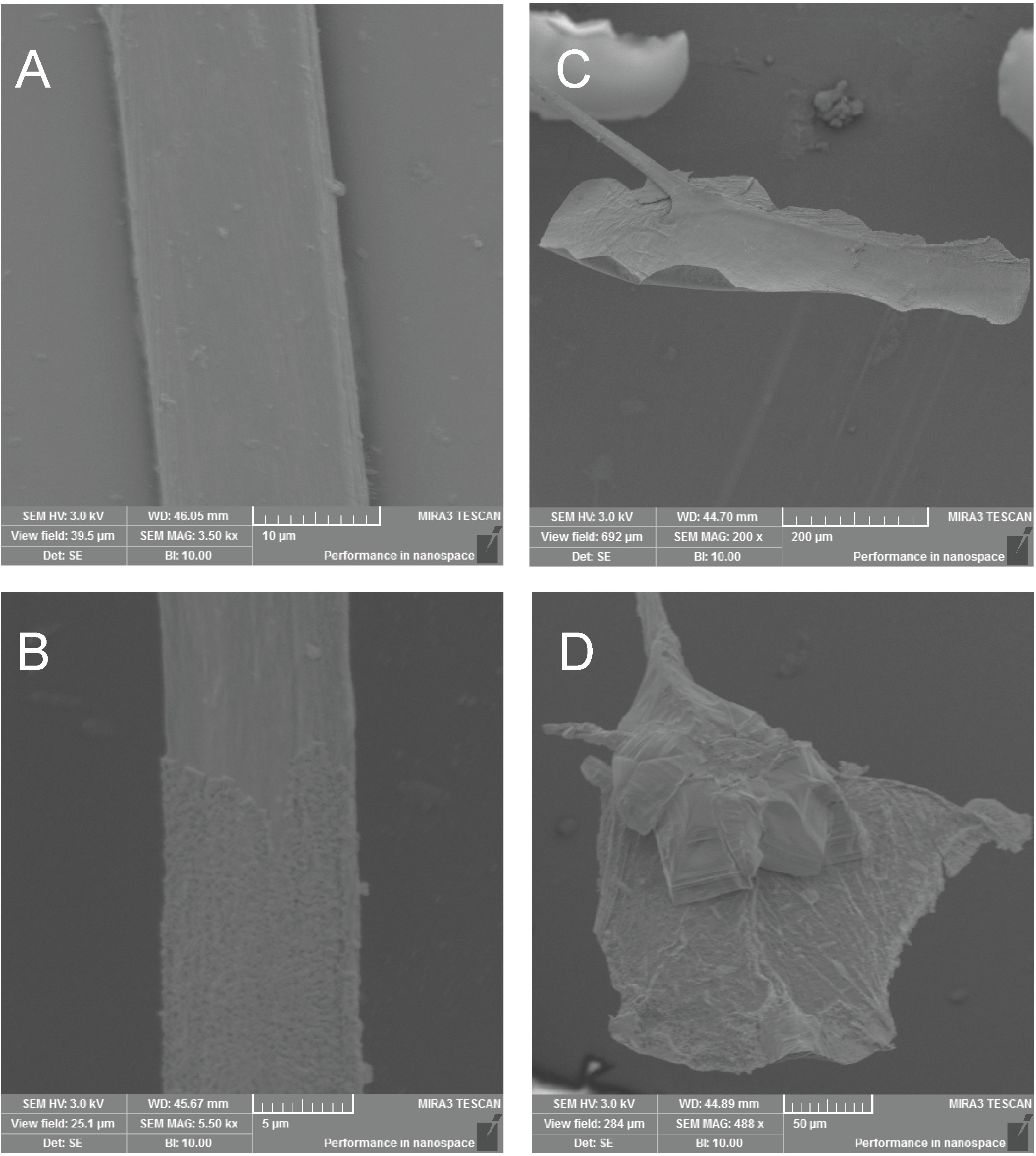
Figure 4 Electron microscopic observation of the byssal thread and adhesive plaque in Mytella strigata grown under ambient and heatwaves conditions. (A) Byssal thread under ambient conditions. (B) Byssal thread under heatwaves conditions. (C) Adhesive plaque under ambient conditions. (D) Adhesive plaque under heatwaves conditions.
Compared with mussels grown under ambient conditions, concentrations of Zn2+ and Fe3+ in byssal threads secreted by heatwaves-stressed mussels were significantly increased (p < 0.05; Figure 5), and total amounts of Ca2+ and Al3+ incorporated into byssal threads were significantly decreased (p < 0.05; Figure 5).
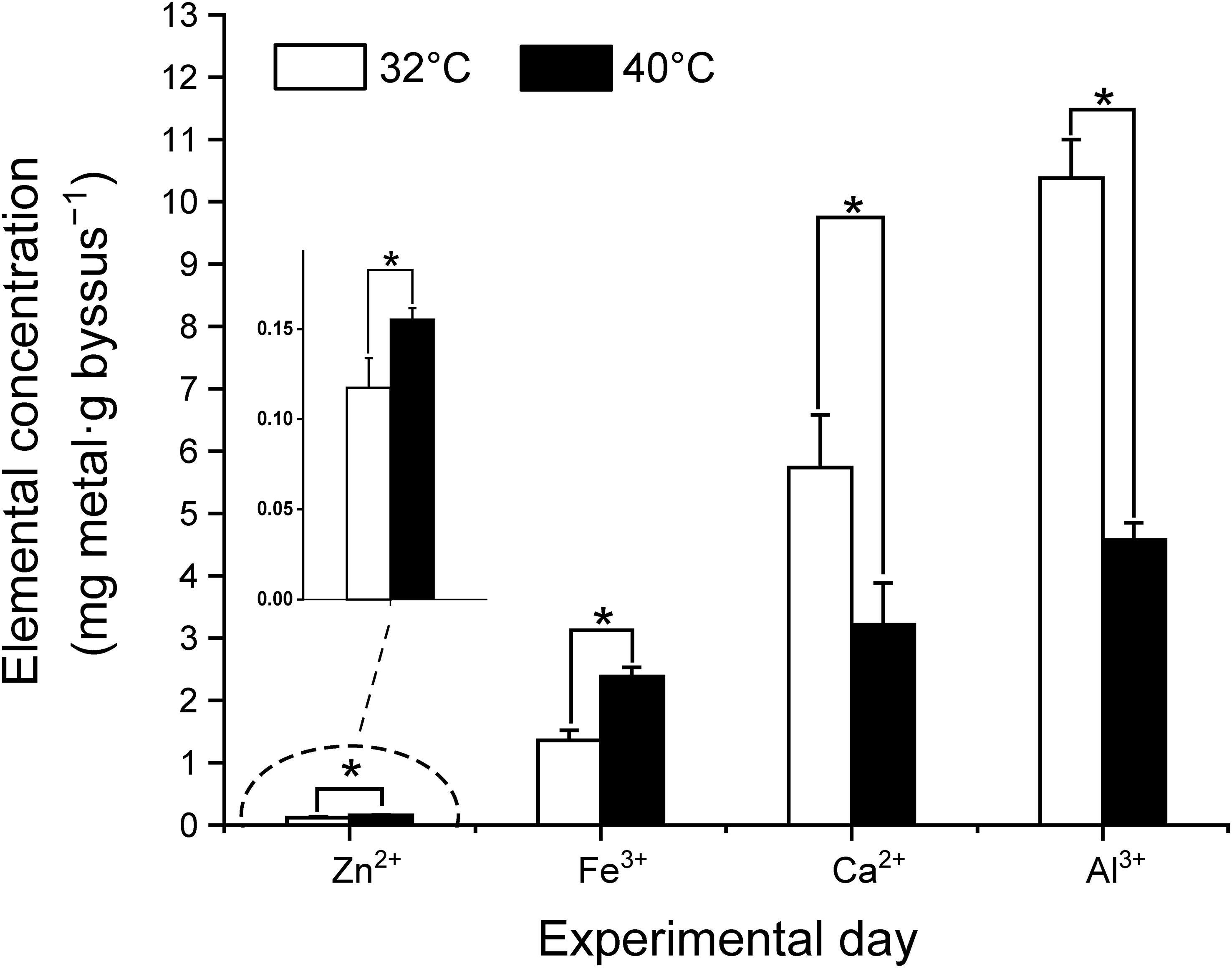
Figure 5 Impacts of heatwaves on Zn2+, Fe3+, Ca2+, Al3+ concentrations of byssal threads in Mytella strigata. Significant differences among treatments were indicated by asterisk.
As demonstrated in Figure 6, when heatwaves attacked, PPO activity in byssal glands was not significantly influenced by the duration and intensity of simulated heatwaves and their interactions (p > 0.05).
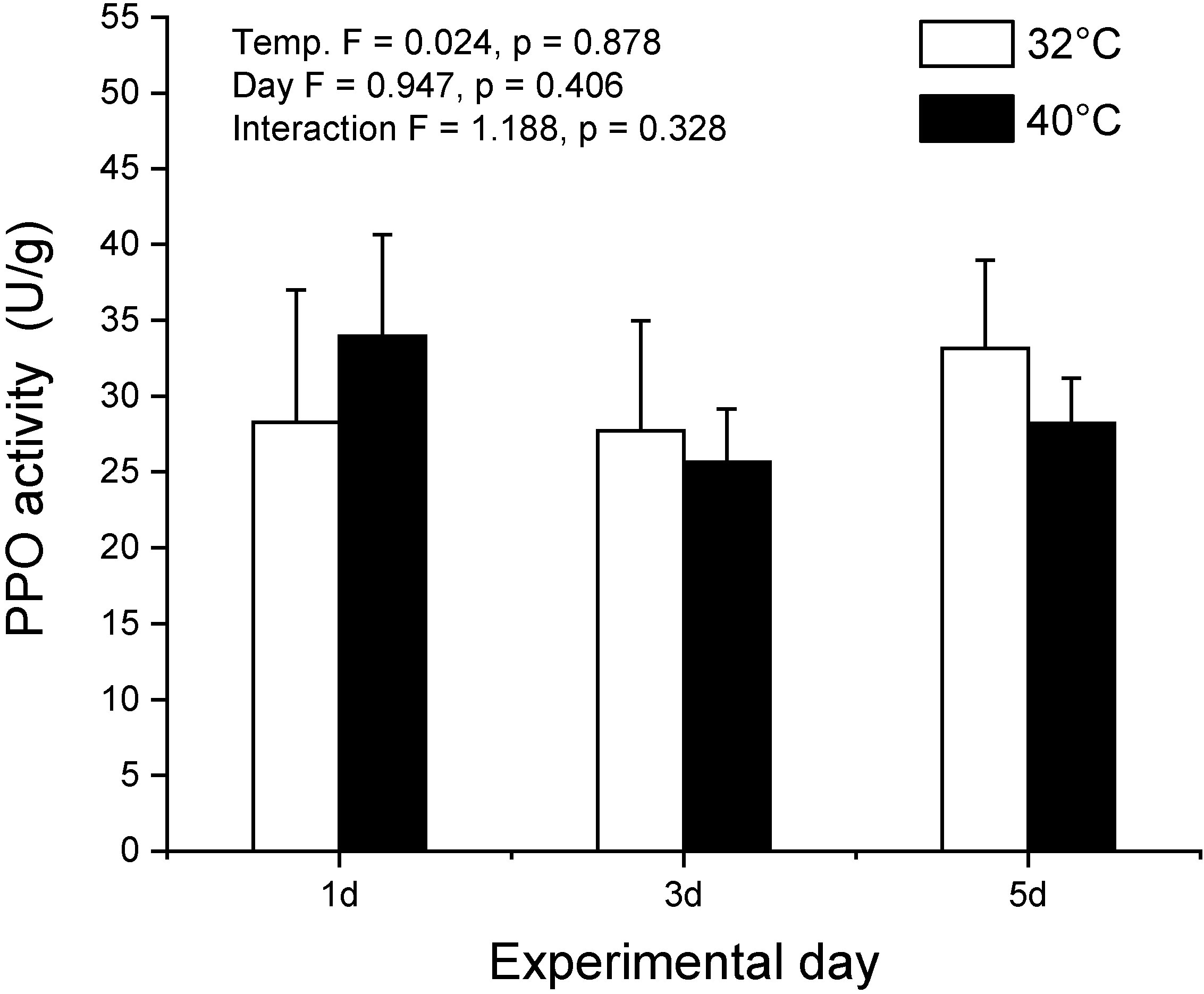
Figure 6 Impacts of heatwaves on the PPO activity of byssal glands in Mytella strigata. Two-way ANOVA analysis indicates impacts of the intensity and duration of heatwaves on the PPO activity.
Relative expression levels of the genes involved byssus production in response to simulated heatwaves were shown in Figure 7. Specifically, following exposure to heatwaves, the expression of the foot protein gene Mfp1-3 was up-regulated, but the expressions of genes Mfp-4 and the precursor collagen (PreCol) were down-regulated. Likewise, the expression of cell apoptosis genes increased when heatwaves prevailed. The expressions of extracellular matrix-receptor interaction genes and neuroactive ligand-receptor interaction genes exhibited similar patterns in response to heatwaves, i.e., their levels were consistently down-regulated in heatwaves-stressed mussels.
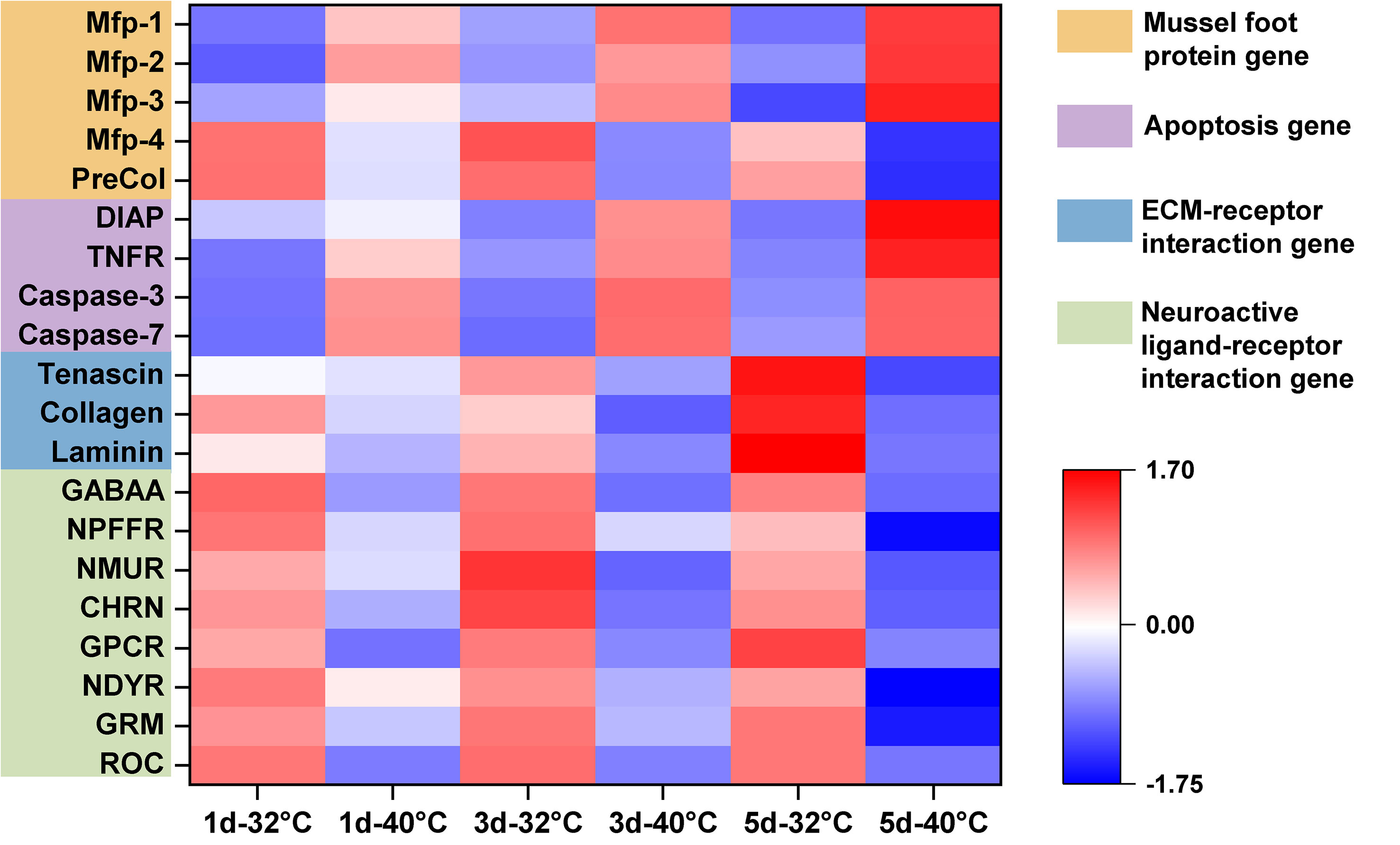
Figure 7 The relative expression levels of key genes (foot protein genes, apoptosis genes, extracellular matrix-receptor interaction genes and neuroactive ligand-receptor interaction genes) in byssal glands of Mytella strigata grown under ambient and heatwaves conditions.
4 Discussion
Considering the survival and physiological tolerance of M. strigata to heatwaves which have frequently occurred in the South China Sea, as demonstrated in Xu et al. (2023a), it is reasonable to hypothesize that M. strigata might have already evolved to cope with impacts of heatwaves on the byssus production. Yet, at various biological levels of organization, it is evident that the capacity of M. strigata to produce byssus was significantly impaired when subjected to heatwaves, thereby offering no support to our previous hypothesis. Heatwaves are among the most important determinant factors capable of constraining the fate of highly invasive fouling species against the background of climate change (Zhao et al., 2019; Xu et al., 2023b), due to their disastrous impacts on organisms and ecosystems (Smale et al., 2019). In particular, heatwaves can facilitate the introduction and establishment of invasive species by enhancing the habitat disturbance of native species (Griffin, 2016). To explain these species- and even habitat-specific discrepancies, it is thus imperative to elucidate how heatwaves affect mussel byssus production.
Virtually unaffected activity of the enzyme PPO observed in heatwaves-stressed byssal glands demonstrates that M. strigata is likely able to implement compensatory mechanisms to cope with heatwaves. PPO plays a fundamental role in the biosynthesis of byssal thread and adhesion of adhesive plaque, by cross-linking the foot protein Mfp-1 within byssal threads and enhancing the conversion of tyrosine residues into dihydroxyphenylalanine required for adhesion (Silverman and Roberto, 2007). When exposed to heatwaves, consequently, highly invasive mussels such as M. strigata might give priority to prevent the thermal degradation of PPO. This assumption is supported by the maintenance of energy budget for essential physiological processes (Xu et al., 2023b). In the extensively-cultured mussel Mytilus coruscus in the East China Sea, thermal stress manipulated at 4°C above mean seawater temperature during summer seasons significantly depressed the PPO activity, and weakened byssus production (Li et al., 2020). Yet, given the unaffected activity of PPO seen in M. strigata subjected to heatwaves, it is reasonable to assume that other physiological processes may be responsible for heatwaves-induced fewer, thinner, and shorter byssal threads and smaller adhesive plaques.
Mussel byssal glands have the ability to absorb metal ions from the surrounding environment through the formation of metal complexes among specific amino acids of the foot protein and heavy metals. In particular, metal ions can participate in the cross-linking of foot protein by interacting with amino acids (cysteine, histidine, etc.), and play an important role in regulating the strength and ductility of byssal threads (Krogsgaard et al., 2013; Reinecke et al., 2017). In mussel byssal threads, Ca2+, Zn2+, Fe3+ and Al3+ have been identified as the most abundant elements (Li et al., 2018). The mechanical property and structural integrity of the byssus are also constrained by the balance between concentrations of foot proteins and metal ions (Seguin-Heine et al., 2014). In M. strigata subjected to heatwaves, concentrations of Zn2+ and Fe3+ in mussel byssal threads significantly increased and Ca2+ and Al3+ significantly decreased compared with those grown at ambient conditions. Previous studies found that the equilibriums of metal ions in pearl oyster byssal threads were disturbed by ocean acidification, leading to a decrease in byssal thread mechanical properties (Li et al., 2017). Therefore, these findings indicate that heatwaves may also alter the homeostasis of metal ions in byssal threads, likely affecting the adhesion of byssal threads.
Specifically, Ca2+ can mediate the coupling of the histidine-rich structural domain of Mfp-4 to the histidine-rich terminus of PreCol, thereby allowing Mfp-4 to function as a macromolecular bifunctional junction (Zhao and Waite, 2006). Due to the down-regulation of Mfp-4 and PreCol gene expression levels, the content of Mfp-4 and PreCol in byssus decreased, so the Ca2+ concentration decreased accordingly. Fe3+ is the main element of byssus adhesion properties (Yap and Tan, 2007), and mussels pump Fe3+ through the byssus to enhance the adhesion strength (Sever et al., 2004). As demonstrated by Hwang et al. (2010) and Lee et al. (2011), Fe3+ could significantly affect the interaction of Mfp-2 and Mfp-3 by binding to specific amino acid residues and maintaining the core function of the adhesive plaque. Zn2+ is mainly cross-linked to Mfp-1. In addition, mussels can opportunistically replace Al3+ with Fe3+ in the byssal threads (Schmitt et al., 2015b), and Fe3+ can replace Al3+ to maintain the stiffness and hardness of the byssus. These observations may lend further support to significant changes of Ca2+, Zn2+, Fe3+ and Al3+ concentrations in the byssal threads.
The expressions of genes involved in byssus production provide further insights into impacts of heatwaves at lowered levels of biological organization. Expressions of four categories of genes (foot protein gene, cell apoptosis gene, extracellular matrix-receptor interaction gene, and neuroactive ligand-receptor interaction gene) in byssal glands demonstrate that changes in the quantity and quality of byssus may be caused by changes in the physiology of byssal glands. Caspases play a key role in the apoptotic pathway (Creagh et al., 2003). Caspase-3 and Caspase-9 genes are activated in oysters subjected to ocean acidification thus triggering apoptosis (Kvitt et al., 2015), and these studies suggest a close link between apoptosis and environmental stress. Following exposure to heatwaves, the expression levels of Caspase-3 and Caspase-7 genes were significantly increased, indicating that byssal glands of M. strigata may be affected by heatwaves by triggering the apoptosis process. In addition, the response of byssus production to heatwaves can be explained in energetic terms. Adaptation and stress tolerance in bivalves are limited by energy balance (Sokolova et al., 2012). Byssus production is extremely energy intensive, accounting for 2% to 10% to nearly 50% of the daily energy budget (Roberts et al., 2021). Therefore, when apoptosis occurs in the organism, more energy may be preferentially allocated to maintain fitness-related functions (Leung et al., 2020), leading to a decrease in byssus production. The findings are consistent with Sokolova et al. (2012)’s metabolic principles of stress response.
The impact of heatwaves on the byssus production of M. strigata was also reflected in the down-regulated expression of extracellular matrix-receptor interaction genes and neuroactive ligand-receptor interaction genes. The level of expression of extracellular matrix-receptor interaction genes can affect muscle performance of byssal glands (Li et al., 2017). The extracellular matrix, a mixture of structural and functional macromolecules such as tenascin, laminin and collagen (Humphrey et al., 2014), is essential for tissue structural integrity and plays a critical role in controlling adhesion. The down-regulation of collagen, tenascin and laminin gene expression levels reflects the lower expression of genes encoding these macromolecules in mussels, which may affect the motility of the byssal gland and thus lead to reduced byssus production, as byssal gland extension is a prerequisite for byssus production. (Yu et al., 2011; Andrade et al., 2015). Behavioral changes in organisms are regulated by the nervous system, which has recently received more attention (Wang and Wang, 2020). Expression levels of multiple nerve-related genes in byssal glands of M. strigata were down-regulated following exposure to heatwaves, suggesting that heatwaves can induce mussel nervous system dysfunction, which may in turn change the behavior of byssal glands. However, the specific mechanisms involved are still poorly understood and deserve further investigation.
5 Conclusion
The present study demonstrates that heatwaves can have negative impacts on byssus production of highly invasive mussels M. strigata. These impacts can be manifested at various biological levels of organization. From the individual appearance, the heatwaves led to the decline of the byssus production and quality (length, diameter and volume of byssal threads); from the physiological level, the heatwaves disturbed the metal ion content of the byssal threads, affecting the cross-linking interaction between the byssus protein and the metal ion, reducing movement and impairing physiology of byssal glands, thereby affecting energy allocation of the body; at the molecular level, the heatwaves caused changes in the expression of multiple genes in the byssal glands. However, given the survival and physiological tolerance of M. strigata to heatwaves, it is imperative to elucidate how mussels may likely allocate the energy budget to essential physiological processes and fitness-related functions when heatwaves attacked. As we enter an era of unprecedented climate change, such information is crucial for linking extreme weather events and biological invasions.
Data availability statement
The raw data supporting the conclusions of this article will be made available by the authors, without undue reservation.
Author contributions
XX: methodology, investigation & writing-Original draft preparation. KY: methodology & investigation. YL: methodology. YD: investigation. LZ: conceptualization, methodology, investigation & writing-original draft preparation. All authors contributed to the article and approved the submitted version.
Funding
The present study has been made possible by grants from the Department of Education of Guangdong Province (2020KTSCX050 and 2022ZDZX4012), the China Scholarship Council (NO. 2023-21), the National Science Foundation of China (42076121, M-0163, 42211530423), the Guangdong Zhujiang Talents Program (2021QN02H665), and the program for Scientific Research Start-up Funds of Guangdong Ocean University.
Conflict of interest
The authors declare that the research was conducted in the absence of any commercial or financial relationships that could be construed as a potential conflict of interest.
Publisher's note
All claims expressed in this article are solely those of the authors and do not necessarily represent those of their affiliated organizations, or those of the publisher, the editors and the reviewers. Any product that may be evaluated in this article, or claim that may be made by its manufacturer, is not guaranteed or endorsed by the publisher.
References
Amini S., Kolle S., Petrone L., Ahanotu O., Sunny S., Sutanto C. N., et al. (2017). Preventing mussel adhesion using lubricant-infused materials. Science 357, 668–673. doi: 10.1126/science.aai8977
Andrade G. R., de Araújo J. L. F., Nakamura Filho A., Guañabens A. C. P., de Carvalho M. D., Cardoso A. V. (2015). Functional Surface of the golden mussel’s foot: morphology, structures and the role of cilia on underwater adhesion. Mater. Sci. Engineering: C 54, 32–42. doi: 10.1016/j.msec.2015.04.032
Balogh R., Byrne M. (2020). Developing in a warming intertidal, negative carry over effects of heatwave conditions in development to the pentameral starfish in Parvulastra exigua. Mar. Environ. Res. 162, 105083. doi: 10.1016/j.marenvres.2020.105083
Bellard C., Rysman J.-F., Leroy B., Claud C., Mace G. M. (2017). A global picture of biological invasion threat on islands. Nat. Ecol. Evol. 1, 1862–1869. doi: 10.1038/s41559-017-0365-6
Creagh E. M., Conroy H., Martin S. J. (2003). Caspase-activation pathways in apoptosis and immunity. Immunol. Rev. 193, 10–21. doi: 10.1034/j.1600-065X.2003.00048.x
Crespo D., Leston S., Rato L. D., Martinho F., Novais S. C., Pardal M. A., et al. (2021). Does an invasive bivalve outperform its native congener in a heat wave scenario? A laboratory study case with Ruditapes decussatus and R. philippinarum. Biology 10, 1284. doi: 10.3390/biology10121284
Ding J., Li J., Yang D., Yang F., Nie H., Huo Z., et al. (2018). Molecular characteristics of a novel HSP60 gene and its differential expression in Manila clams (Ruditapes philippinarum) under thermal and hypotonic stress. Cell Stress Chaperones 23, 179–187. doi: 10.1007/s12192-017-0796-7
Frölicher T. L., Fischer E. M., Gruber N. (2018). Marine heatwaves under global warming. Nature 560, 360–364. doi: 10.1038/s41586-018-0383-9
Griffin S. L. C., Hodgins K. A., Philippa C. (2016). “Biological invasions, climate change and genomics,” in Crop Breeding (Apple Academic Press).
He G., Zou J., Liu X., Liang F., Liang J., Yang K., et al. (2022). Assessing the impact of atmospheric heatwaves on intertidal clams. Sci. Total Environ. 841, 156744. doi: 10.1016/j.scitotenv.2022.156744
He G., Xiong X., Peng Y., Yang T., Xu C., Liu X., et al. (2023). Transcriptomic responses reveal impaired physiological performance of the pearl oyster following repeated exposure to marine heatwaves. Science of The Total Environment 854, 158726. doi: 10.1016/j.scitotenv.2022.158726
Helmuth B., Choi F., Matzelle A., Torossian J. L., Morello S. L., Mislan K. a. S., et al. (2016). Long-term, high frequency in situ measurements of intertidal mussel bed temperatures using biomimetic sensors. Sci. Data 3, 160087. doi: 10.1038/sdata.2016.87
Hobday A. J., Alexander L. V., Perkins S. E., Smale D. A., Straub S. C., Oliver E. C., et al. (2016). A hierarchical approach to defining marine heatwaves. Prog. Oceanogr. 141, 227–238. doi: 10.1016/j.pocean.2015.12.014
Huang X., Leung J. Y. S., Hu M., Xu E. G., Wang Y. (2022). Microplastics can aggravate the impact of ocean acidification on the health of mussels: insights from physiological performance, immunity and byssus properties. Environ. pollut. 308, 119701. doi: 10.1016/j.envpol.2022.119701
Humphrey J. D., Dufresne E. R., Schwartz M. A. (2014). Mechanotransduction and extracellular matrix homeostasis. Nat. Rev. Mol. Cell Biol. 15, 802–812. doi: 10.1038/nrm3896
Hwang D. S., Zeng H., Masic A., Harrington M. J., Israelachvili J. N., Waite J. H. (2010). Protein- and metal-dependent interactions of a prominent protein in mussel adhesive plaques. J. Biol. Chem. 285, 25850–25858. doi: 10.1074/jbc.M110.133157
IPCC. (2019). Summary for policymakers – global warming of 1.5 °C. IPCC Special Report on the Ocean and Cryosphere in a Changing Climate (IPCC, 2019).
Krogsgaard M., Behrens M. A., Pedersen J. S., Birkedal H. (2013). Self-healing mussel-inspired multi-pH-responsive hydrogels. Biomacromolecules 14, 297–301. doi: 10.1021/bm301844u
Kvitt H., Kramarsky-Winter E., Maor-Landaw K., Zandbank K., Kushmaro A., Rosenfeld H., et al. (2015). Breakdown of coral colonial form under reduced pH conditions is initiated in polyps and mediated through apoptosis. Proc. Natl. Acad. Sci. 112, 2082–2086. doi: 10.1073/pnas.1419621112
Lee B. P., Messersmith P. B., Israelachvili J. N., Waite J. H. (2011). Mussel-inspired adhesives and coatings. Annu. Rev. Mater. Res. 41, 99–132. doi: 10.1146/annurev-matsci-062910-100429
Leung J. Y., Russell B. D., Connell S. D. (2019). Adaptive responses of marine gastropods to heatwaves. One Earth 1, 374–381. doi: 10.1016/j.oneear.2019.10.025
Leung J. Y., Russell B. D., Connell S. D. (2020). Linking energy budget to physiological adaptation: how a calcifying gastropod adjusts or succumbs to ocean acidification and warming. Sci. Total Environ. 715, 136939. doi: 10.1016/j.scitotenv.2020.136939
Li S., Liu C., Zhan A., Xie L., Zhang R. (2017). Influencing mechanism of ocean acidification on byssus performance in the pearl oyster Pinctada fucata. Environ. Sci. Technol. 51, 7696–7706. doi: 10.1021/acs.est.7b02132
Li S., Xia Z., Chen Y., Gao Y., Zhan A. (2018). Byssus structure and protein composition in the highly invasive fouling mussel limnoperna fortunei. Front. Physiol. 9, 418. doi: 10.3389/fphys.2018.00418
Li Y., Yang X., Cheng Z., Wang L., Wang W., Liang X., et al. (2020). Near-future levels of ocean temperature weaken the byssus production and performance of the mussel Mytilus coruscus. Sci. Total Environ. 733, 139347. doi: 10.1016/j.scitotenv.2020.139347
Lim J. Y., Tay T. S., Lim C. S., Lee S. S. C., Teo S. L. M., Tan K. S. (2018). Mytella strigata (Bivalvia: Mytilidae): an alien mussel recently introduced to Singapore and spreading rapidly. Molluscan Res. 38, 170–186. doi: 10.1080/13235818.2018.1423858
Lin Q., Gourdon D., Sun C., Holten-Andersen N., Anderson T. H., Waite J. H., et al. (2007). Adhesion mechanisms of the mussel foot proteins mfp-1 and mfp-3. Proc. Natl. Acad. Sci. 104, 3782–3786. doi: 10.1073/pnas.0607852104
Liu C., Li S., Huang J., Liu Y., Jia G., Xie L., et al. (2015). Extensible byssus of Pinctada fucata: Ca2+-stabilized nanocavities and a thrombospondin-1 protein. Sci. Rep. 5, 15018. doi: 10.1038/srep15018
Ma P., Li H., Liu Y., Li C., Zhang Z., Wang H. (2022). First confirmed occurrence of the invasive mussel Mytella strigata (Hanley 1843) in Guangdong and Hainan, China, and its rapid spread in Indo-West Pacific regions. BioInvasions Records 11, 947–963. doi: 10.3391/bir.2022.11.4.13
Mediodia D. P., De Leon S. M. S., Anasco N. C., Baylon C. C. (2017). Shell morphology and anatomy of the Philippine charru mussel Mytella charruana (d’Orbigny 1842). Asian Fisheries Sci. 30, 185194. doi: 10.33997/j.afs.2017.30.3.004
O’Donnell M. J., George M. N., Carrington E. (2013). Mussel byssus attachment weakened by ocean acidification. Nat. Climate Change 3, 587–590. doi: 10.1038/nclimate1846
Perkins-Kirkpatrick S. E., Lewis S. C. (2020). Increasing trends in regional heatwaves. Nat. Commun. 11, 3357. doi: 10.1038/s41467-020-16970-7
Reinecke A., Brezesinski G., Harrington M. J. (2017). pH-responsive self-organization of metal-binding protein motifs from biomolecular junctions in mussel byssus. Advanced Mater. Interfaces 4, 1600416. doi: 10.1002/admi.201600416
Roberts E. A., Newcomb L. A., McCartha M. M., Harrington K. J., LaFramboise S. A., Carrington E., et al. (2021). Resource allocation to a structural biomaterial: induced production of byssal threads decreases growth of a marine mussel. Funct. Ecol. 35, 1222–1239. doi: 10.1111/1365-2435.13788
Sanpanich K., Wells F. E. (2019). Mytella strigata (Hanley 1843) emerging as an invasive marine threat in Southeast Asia. Bioinvasions Records 8, 343–356. doi: 10.3391/bir.2019.8.2.16
Scanes E., Siboni N., Rees B., Seymour J. R. (2023). Acclimation in intertidal animals reduces potential pathogen load and increases survival following a heatwave. iScience 26, 106813. doi: 10.1016/j.isci.2023.106813
Schmitt C. N. Z., Politi Y., Reinecke A., Harrington M. J. (2015a). Role of sacrificial protein–metal bond exchange in mussel byssal thread self-healing. Biomacromolecules 16, 2852–2861. doi: 10.1021/acs.biomac.5b00803
Schmitt C. N. Z., Winter A., Bertinetti L., Masic A., Strauch P., Harrington M. J. (2015b). Mechanical homeostasis of a DOPA-enriched biological coating from mussels in response to metal variation. J. R. Soc. Interface 12, 20150466. doi: 10.1098/rsif.2015.0466
Seguin-Heine M.-O., Lachance A.-A., Genard B., Myrand B., Pellerin C., Marcotte I., et al. (2014). Impact of open sea habitat on byssus attachment of suspension-cultured blue mussels (Mytilus edulis). Aquaculture 426–427, 189–196. doi: 10.1016/j.aquaculture.2014.02.006
Sever M. J., Weisser J. T., Monahan J., Srinivasan S., Wilker J. J. (2004). Metal-mediated cross-linking in the generation of a marine-mussel adhesive. Angewandte Chemie Int. Edition 43, 448–450. doi: 10.1002/anie.200352759
Shang Y., Gu H., Li S., Chang X., Sokolova I., Fang J. K. H., et al. (2021). Microplastics and food shortage impair the byssal attachment of thick-shelled mussel Mytilus coruscus. Mar. Environ. Res. 171, 105455. doi: 10.1016/j.marenvres.2021.105455
Silverman H. G., Roberto F. F. (2007). Understanding marine mussel adhesion. Mar. Biotechnol. 9, 661–681. doi: 10.1007/s10126-007-9053-x
Smale D. A., Wernberg T., Oliver E. C. J., Thomsen M., Harvey B. P., Straub S. C., et al. (2019). Marine heatwaves threaten global biodiversity and the provision of ecosystem services. Nat. Clim. Chang. 9, 306–312. doi: 10.1038/s41558-019-0412-1
Smith K. E., Burrows M. T., Hobday A. J., Sen Gupta A., Moore P. J., Thomsen M., et al. (2021). Socioeconomic impacts of marine heatwaves: global issues and opportunities. Science 374, eabj3593. doi: 10.1126/science.abj3593
Sokolova I. M., Frederich M., Bagwe R., Lannig G., Sukhotin A. A. (2012). Energy homeostasis as an integrative tool for assessing limits of environmental stress tolerance in aquatic invertebrates. Mar. Environ. Res. 79, 1–15. doi: 10.1016/j.marenvres.2012.04.003
Wang T., Wang Y. (2020). Behavioral responses to ocean acidification in marine invertebrates: new insights and future directions. J. Oceanol. Limnol. 38, 759–772. doi: 10.1007/s00343-019-9118-5
Wangkulangkul K., Hayeewachi L., Rodcharoen E. (2022). Changes in benthic macro-invertebrate assemblages in an estuary in southern Thailand after invasion by non-native bivalves Mytilopsis sallei and Mytella strigata. Plankton Benthos Res. 17, 137–146. doi: 10.3800/pbr.17.137
Xu X., Tong Y., Deng Y., Zhao L. (2023a). Impacts of marine heatwaves on byssus production in highly invasive fouling mussels. Mar. Environ. Res. 184, 105871. doi: 10.1016/j.marenvres.2022.105871
Xu X., Zhang X., Peng J., Deng Y., Liu Y., Jiang L., et al. (2023b). Survival and physiological energetics of highly invasive mussels exposed to heatwaves. Mar. Environ. Res. 187, 105948. doi: 10.1016/j.marenvres.2023.105948
Yap C., Tan S. (2007). Iron (Fe) concentrations in the byssus and soft tissues of the green-lipped mussel Perna viridis (L.): Byssus as an excretion route of Fe and Fe bioavailability in the coastal waters. Indian J. Mar. Sci. 36 (3), 227–234. Available at: http://nopr.niscpr.res.in/handle/123456789/48.
Yu J., Wei W., Danner E., Ashley R. K., Israelachvili J. N., Waite J. H. (2011). Mussel protein adhesion depends on interprotein thiol-mediated redox modulation. Nat. Chem. Biol. 7, 588–590. doi: 10.1038/nchembio.630
Zhang W., Zheng Z., Zhang T., Chen T. (2020). Analysis of the reasons for the intensification of marine heatwaves in the coral reef area of Beibu Gulf during 1960–2017. Acta Ocean. Sin. 42, 41–48.
Zhao L., Liu B., An W., Deng Y., Lu Y., Liu B. (2019). Assessing the impact of elevated pCO2 within and across generations in a highly invasive fouling mussel (Musculista senhousia). Science of The Total Environment 689, 322–331. doi: 10.1016/j.scitotenv.2019.06.466
Zhao L., Liang J., Liang J., Liu B., Deng Y., Sun X., et al. (2020). Experimental study of transgenerational effects, pH and predation risk on byssus production in a swiftly spreading invasive fouling Asian mussel, Musculista senhousia (Benson). Environ. pollut. 260, 114111. doi: 10.1016/j.envpol.2020.114111
Keywords: extreme weather events, climate change, biological invasion, byssal threads, Mytella strigata
Citation: Xu X, Yang K, Liu Y, Deng Y and Zhao L (2023) Heatwaves hinder mussel invasion by weakening byssus production. Front. Mar. Sci. 10:1239801. doi: 10.3389/fmars.2023.1239801
Received: 14 June 2023; Accepted: 24 August 2023;
Published: 12 September 2023.
Edited by:
Linn Hoffmann, University of Otago, New ZealandReviewed by:
Jose M. F. Babarro, Spanish National Research Council (CSIC), SpainJonathan Y. S. Leung, University of Adelaide, Australia
Youji Wang, Shanghai Ocean University, China
Copyright © 2023 Xu, Yang, Liu, Deng and Zhao. This is an open-access article distributed under the terms of the Creative Commons Attribution License (CC BY). The use, distribution or reproduction in other forums is permitted, provided the original author(s) and the copyright owner(s) are credited and that the original publication in this journal is cited, in accordance with accepted academic practice. No use, distribution or reproduction is permitted which does not comply with these terms.
*Correspondence: Liqiang Zhao, bHpoYW9AZ2RvdS5lZHUuY24=
 Xin Xu
Xin Xu Ke Yang1
Ke Yang1 Yuewen Deng
Yuewen Deng Liqiang Zhao
Liqiang Zhao